Southern Texas is one of the US territories where many moths are seen throughout the year.
Texas is also the state where moths may be found both in remote areas and in urban areas. They can feed on nectar as well as on plant leaves as caterpillars.
Some moths in Texas are pests and known defoliators which means they require proper management techniques.
Here are some of the most common moths in Texas in all regions of the state.
Table of Contents
1. Salt Marsh Moth
Seen throughout the year in Southern Texas, The Salt Marsh Moth (Estigmene acrea) is among the most common moths in Texas.
This species has a dual white-orange color or white-yellow color combination.

Its upper thorax and forewings are white or off-white whole of its lower body and its hindwings are yellow or yellow-orange.
Unlike other dual-colored species, The Salt Marsh Moth has black dots decorating its wings and body. Various size black dots contrast its bright appearance.
The caterpillars of the species may be harmful to plants and legumes. Their hosts include dandelions, cabbage, and cotton.
Wingspan – 1-2 inches
2. White-lined Sphinx

A multicolored body is characteristic of The White-lined Sphinx (Hyles lineata).
This type of moth is dominated by brown and tan nuances with white and pink bands across its wings.
Small coloring differences are seen between the dorsal and the ventral side of the species. Its dorsal side shows more vivid coloring.
This species feeds on flowers and wildflowers both as a caterpillar and as an adult.
White-lined Sphinx moths are either diurnal or nocturnal. Sometimes they can be active both during the day and during the night.
Nectar consumed by adults comes from different species such as columbine perennials, flowering petunias, or night-blooming white moonflowers.
Wingspan – 2-3 inches
3. Green Cloverworm Moth

Multiple generations of Green Cloverworm Moths (Hypena scabra) are seen in Texas each year. This species remains active throughout the year in the Southern range of the state.
A small species, Green Cloverworm Moths are dominated by brown and dark brown colors.
These types of moths show a tendency to invade crops and gardens as they lay eggs that turn into legume-eating caterpillars.
Alfalfa and soybean are among the typical crops their caterpillars feed on.
Moths of this species can also lay eggs on trees and shrubs in the absence of these crops in their region.
Wingspan – 0.9 to 1.3 inches
4. Forest Tent Caterpillar Moth

A dark band across the forewings makes for easy Forest Tent Caterpillar Moth (Malacosoma disstria) identification.
Various types of trees in Texas are used as hosts for the caterpillars of the species. This includes hardwood trees.
Oak and maple are among the most common types of trees Forest Tent Caterpillar Moths lay eggs on.
These types of trees are where their colorful black and blue caterpillars are seen together in their initial growth stages.
These moths and their caterpillar may cause outbreaks at any time of the year in Texas. This may lead to the defoliation of their host trees.
Wingspan – 1 to 1.5 inches
5. Polyphemus Moth

Brown coloring is characteristic of Polyphemus Moths (Antheraea polyphemus) through their life stages.
This species lays brown eggs and adults are mostly brown, gray, black, and pink.
A light tan or even yellow color covers the thorax of the moth while its wings show light brown edges and gray or gray-to-brown inner coloring.
Its hindwings show 2 large eyespots comprised of black, blue, and white colors.
The species also shows wavy pink lines with gray or white borders.
Wingspan – 4-7 inches
6. Yellow-striped Armyworm Moth

White and brown colors in a mottled appearance are characteristic of the forewings of The Yellow-striped Armyworm Moth (Spodoptera ornithogalli).
This is a species with dark forewings and white to yellow hindwings.
Yellow-striped Armyworm isn’t a specific feeder among the moths in Texas. It has a varied diet and even a potential pest status.
Some of its common crops include cabbage and sweet potato.
Most of the damages caused to these crops are specific to their caterpillar stage.
Wingspan – 1.3 to 1.6 inches
7. Wedgling Moth

Wedgling Moths (Galgula partita) have a dark red-brown and gray appearance.
Females of the species are brighter and dominated by light brown colors.
A small nocturnal species, this moth is attracted to white flowers such as wood sorrels in its tropical regions.
The species is mostly found in tropical and subtropical climates in Central America but it also makes its way into Southern regions of Texas.
It can be seen almost throughout the year here.
Wingspan – 0.7 to 1 inch
8. Garden Webworm Moth

A bright brown or tan color with white wing margins is specific to this common type of Texas moth (Achyra rantalis).
Often found on crops or gardens, it features a tan to yellow thorax and a diurnal feeding habit.
This type of moth is found around different types of crops and garden legumes.
It prefers alfalfa due to its common nature as well as corn. Fruits such as strawberries can also be highly impacted by the Garden Webworm Moth Caterpillar.
The species is active throughout the year in Southern Texas and from spring onwards in other regions of the state.
Wingspan – 0.6 to 0.9 inches
9. Indomitable Graphic Moth
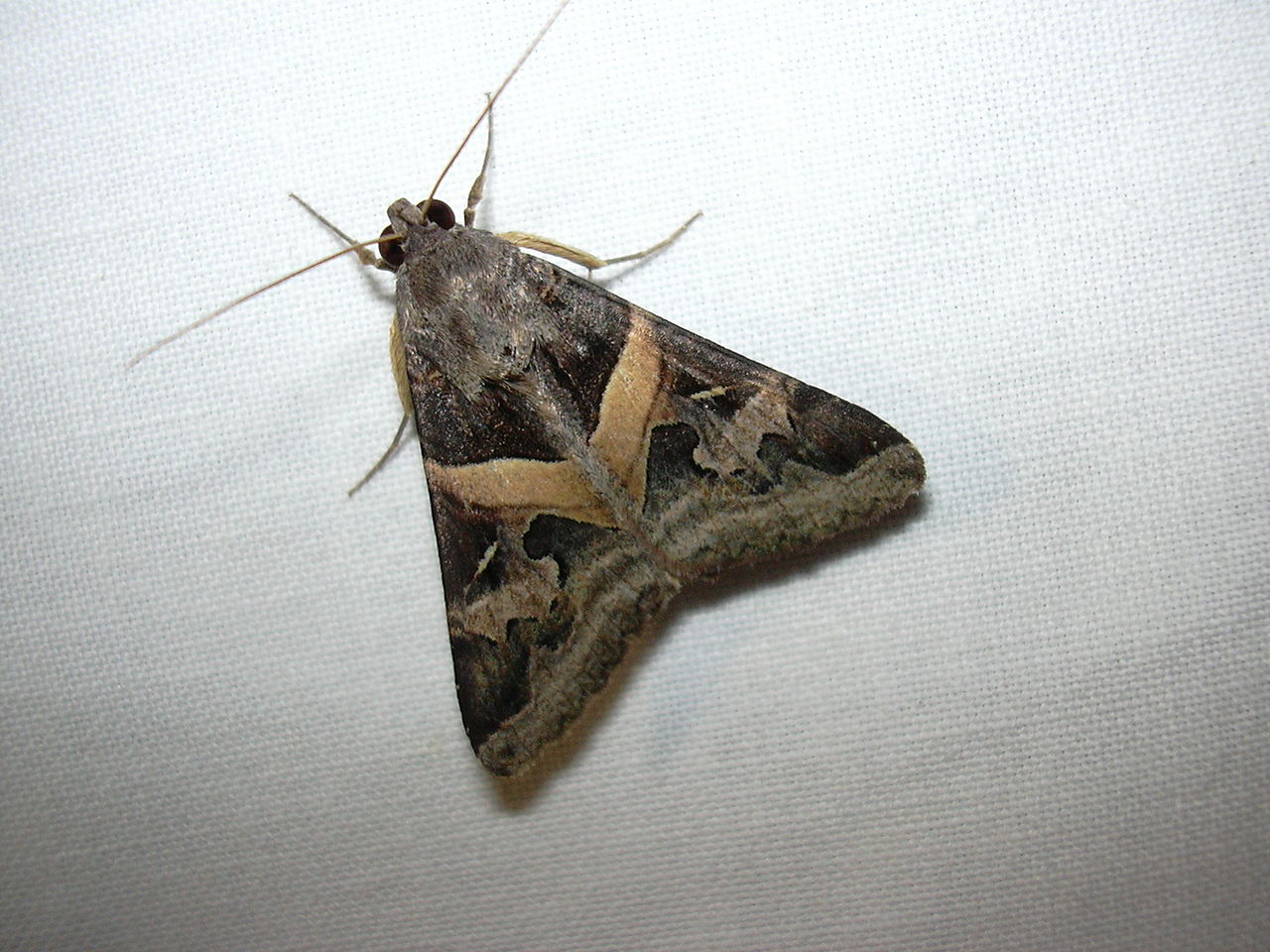
A dark-colored species, The indomitable Graphic Moth (Melipotis indomita) is one of the species with an almost black appearance in Texas.
The hindwings of the species are only visible when it flies. They have a light brown appearance with yellow-white central spots.
This species most notably lives in Southern US territories and parts of Central America.
Most of the moths and caterpillars of the species live on mesquite.
Its caterpillars are identified by their dark brown and light brown color combination.
Wingspan – 1.5 to 2.1 inches
10. Fall Webworm Moth
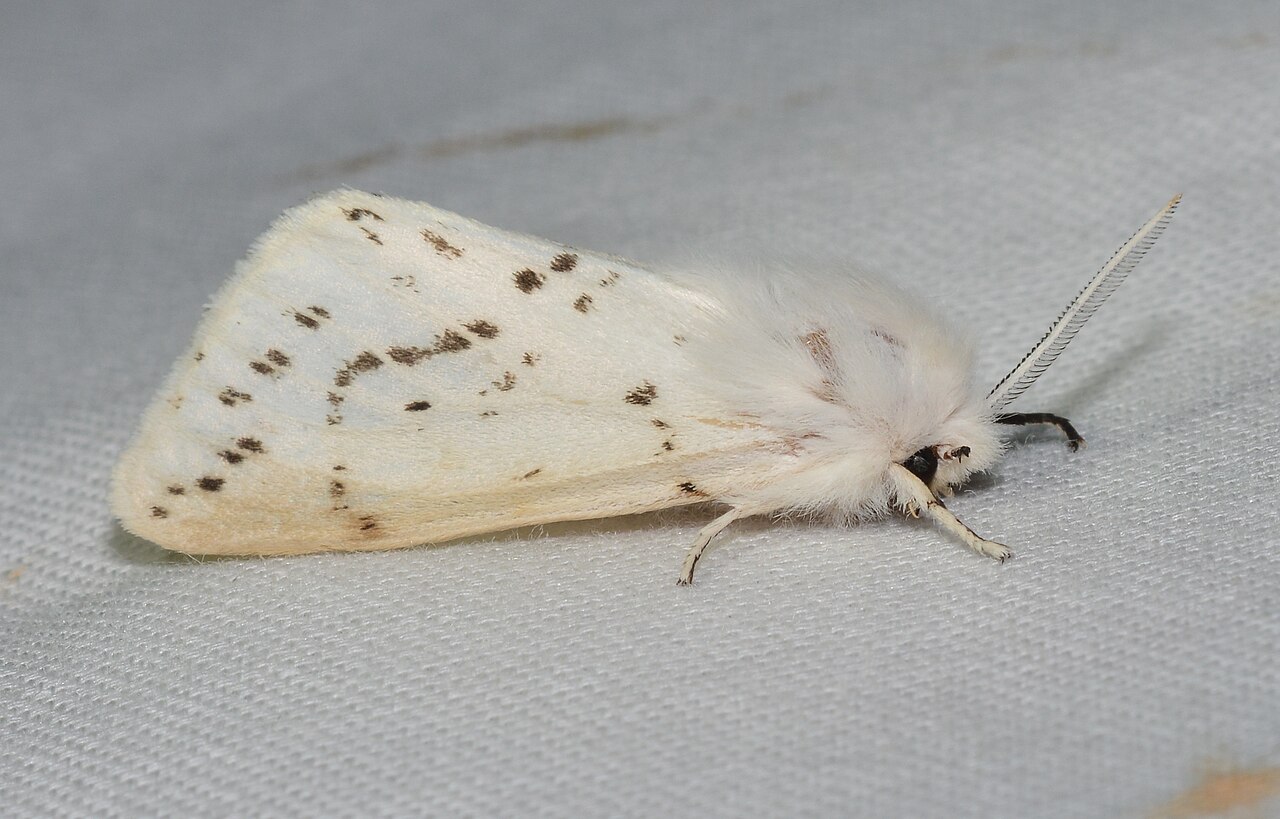
A white moth in Texas, The Fall Webworm Moth (Hyphantria cunea) is among the typical species known for their bright appearance and average-length wingspan.
Both males and females of the species are mainly white. Male Fall Webworm Moths may also feature black spots on the forewings.
This species is seen around trees where it lays eggs that turn into social caterpillars. These caterpillars build silk tents to protect them from predators.
Wingspan – 1 to 1.3 inches
11. Southern Flannel Moth
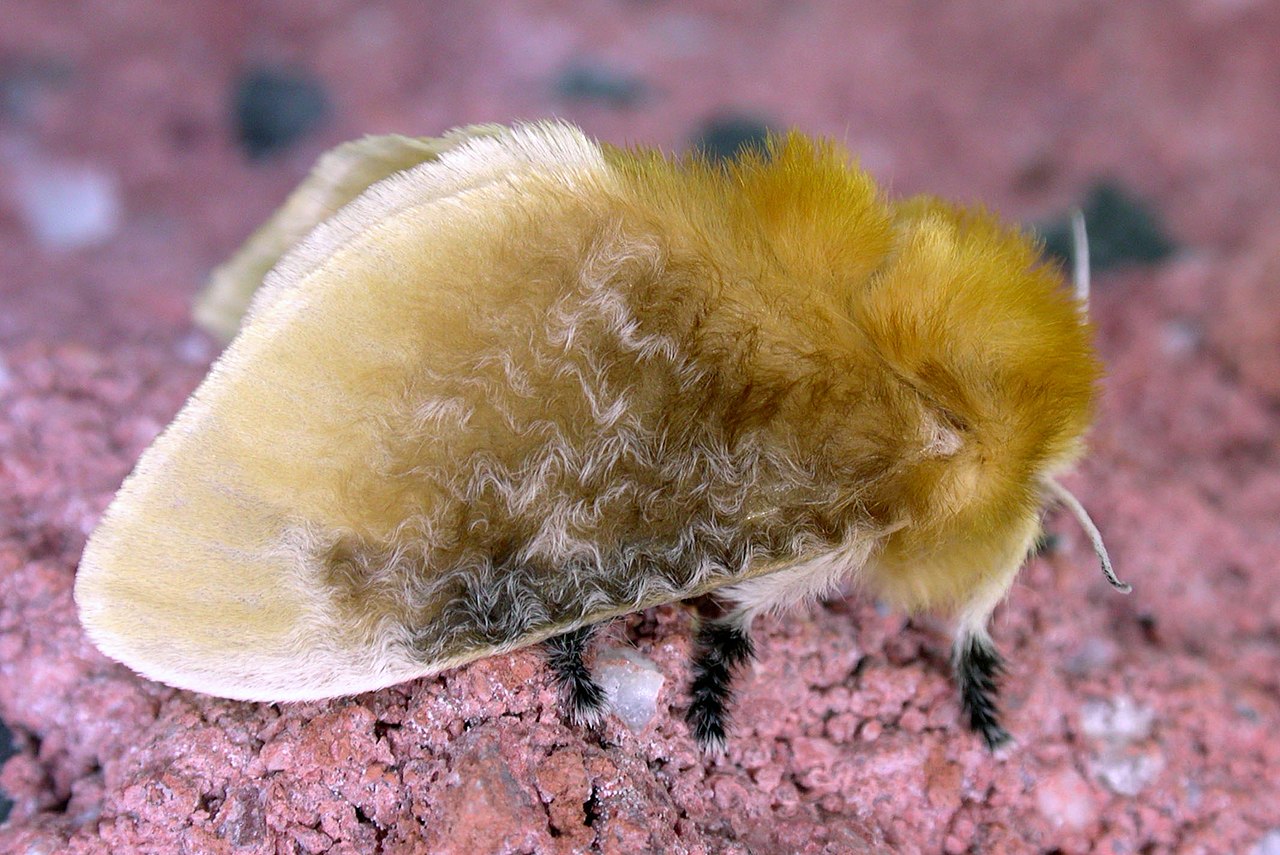
Southern Flannel Moths (Megalopyge opercularis) also live in Texas, with a range expanding to almost all Southern states.
This bright species is yellow and orange with an initial yellow color in its caterpillar stages.
Its wings are yellow and white while its body is darker yellow or orange.
Covered in short setae, this species looks like a type of fuzzy moth.
Some of its most common areas in the state include parts of San Antonio and the extended range around Galveston.
Wingspan – 1 to 1.15 inches
12. Ailanthus Webworm Moth

Orange, black, and brown are some of the main colors of this species of webworm moth (Atteva aurea).
The species is easily identifiable by its orange forewings with white spots that feature black borders.
Its hindwings are white to bright brown and are only seen when the species flies.
A common sight in Texas, the moth is adapted to tropical climates but it is North, through Texas, during the summer months.
Wingspan – 0.5 to 1.1 inches
13. Fall Armyworm Moth

Fall Armyworm Moths (Spodoptera frugiperda) are among the most detrimental species across the state. They can invade various crops in almost any part of the state.
Multiple hosts are characteristic of the species. These vary from simple hosts such as trees and shrubs but this moth prefers different grasses.
Bermudagrass and other grasses are among its first hosts. The moth is further interested in corn and tobacco crops.
Once established, this species quickly multiplies, leading to complete crop defoliation if left unmanaged.
Wingspan – 1.2 to 1.5 inches
14. Celery Leaftier Moth

Texas marks the Southeastern border of the North American distribution of the Celery Leaftier Moth (Udea rubigalis).
Brown and red-brown colors are typical to the body and the forewings of this species.
These types of moths are confirmed on tens of hosts ranging from wildflowers such as asters to celery and legumes.
Celery Leaftier Moth Caterpillars tend to cause the most damage as they constantly feed and even defoliate hosts.
Wingspan – 0.6 to 1 inch
15. Belted Grass-Veneer

Corn and grasses are among the first hosts of The Belted Grass-Veneer (Euchromius ocellea).
Also present in Texas, this species is further seen even outside North America.
A cream-gray color is characteristic of its forewings. Yellow stripes contrast its silver-gray color while the margins of its forewings are marked with dark brown spots.
The Belted Grass-Veneer has large dark brown eyes.
Males of this species have a slightly reflective golden color along their wings.
Some of the best areas to spot this species include Fort Worth and Dallas.
Wingspan – 0.6 to 1.1 inches
16. Brown-shaded Gray

Southern and Southeastern parts of the state mark the Western limit of the East US distribution of this moth (Iridopsis defectaria).
Its mottled appearance is geared towards gaining a camouflaging advantage as a means of defense.
From an early age, the caterpillar of this species has a twig-like appearance and a base uniform green color which makes it hard to spot on branches.
Adult moths have white, gray, black, and brown coloring, which makes them easily blend in.
Wingspan – 0.9 to 1.2 inches
17. White-speck Moth

Light brown and tan colors are seen on the wings of the White-speck Moth (Mythimna unipuncta) while its body is mostly dark brown.
This specie is a type of moth that has caterpillars marching in line, similar to other types of armyworms.
All types of host plants are specific to their caterpillars. This includes celery and oats.
Adult moths of the species may also be damaging but to a lesser extent, as they mostly feed on plant nectar.
A typical pest in agriculture, White-speck Moths require management, even if they can migrate away from the state at times.
Wingspan – 1.5 inches
18. Dot-lined Angle

Dot-lined Angle Moths (Psamatodes abydata) are common almost all around Texas.
Some of the key areas of the species include the region between Fort Worth and San Antonio.
Numerous sightings have also been recorded in Corpus Christi.
Dot-lined Angle Moths have a light brown color with dark brown wave-patterned bands across the wings.
This species is seen on different trees and wildflowers, mainly acacia and cassias.
Wingspan – 0.8 to 1 inch
19. Giant Leopard Moth

A contrasting leopard-like appearance and a long wingspan are among the most important traits of The Giant Leopard Moth (Hypercompe scribonia).
This is a species with a pure white base color contrasted by black dots. Hollow black spots are also seen on the species.
A wide range of hosts is specific to its caterpillar. Maple, plums, and plantago are some of its favorites.
The caterpillar of the species has a hairy black appearance which is why most people don’t touch it. The caterpillar of The Giant Leopard Moth may cause skin urticaria.
Wingspan – 2 to 3 inches
20. Hawaiian Beet Webworm Moth
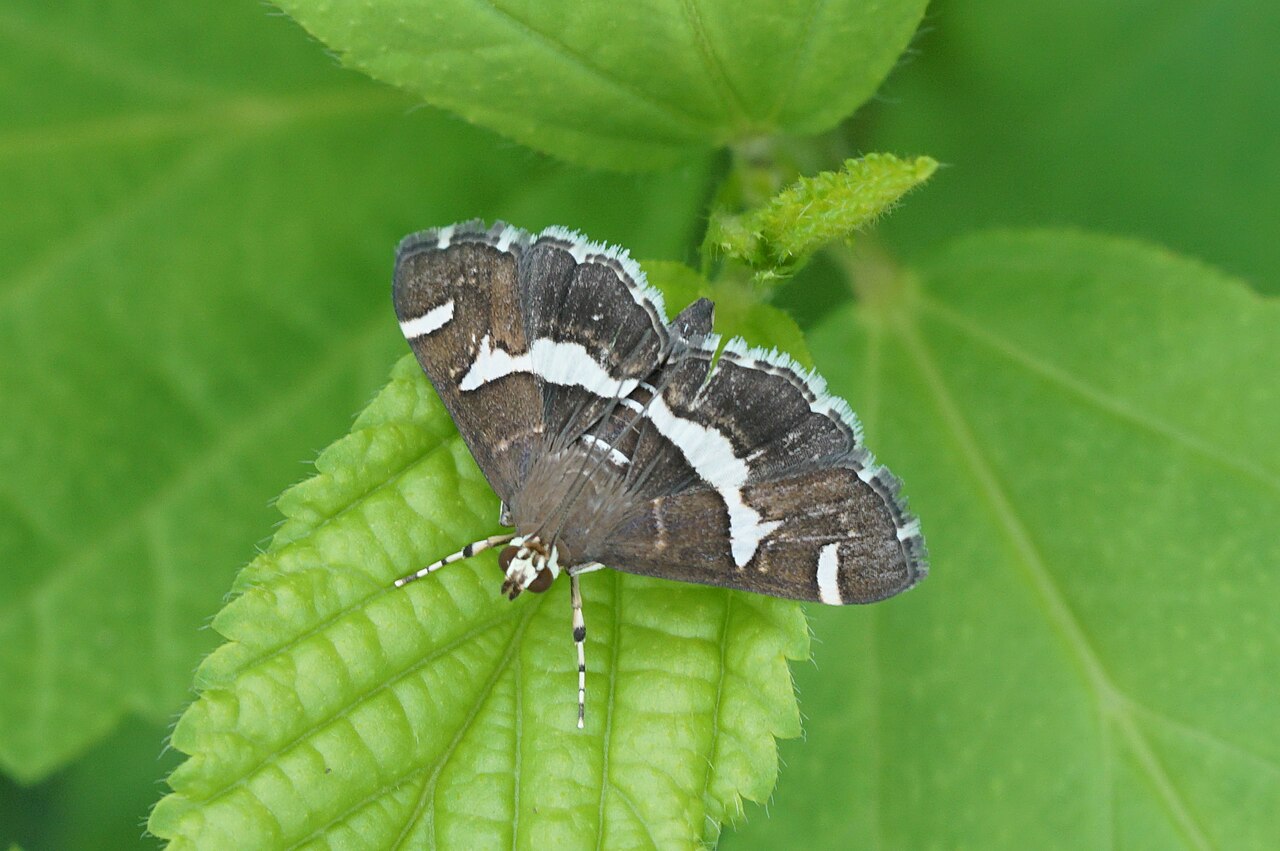
Dark brown and white colors make up the contrasting appearance of The Hawaiian Beet Webworm Moth (Spoladea recurvalis).
This is a species with similar forewings and hindwings, a rare occurrence among moths in Texas.
While adults feed on plant nectar, Hawaiian Beet Webworm Caterpillars feed on legumes and invade crops.
Some of the crops they are pests of include soybean and maize crops.
Much of the lives of these moths are impacted by food accessibility and by the capacity to migrate considerable distances to find new crops.
Wingspan – 0.6 to 0.9 inches
21. Moonseed Moth

A mottled appearance is specific to the dark Moonseed Moth (Plusiodonta compressipalpis).
This species shows a combination of brown, olive, and yellow colors across its body and forewings.
Its coloring helps the species camouflage itself among dying tree and shrub leaves as it looks similar to a leaf.
This species has a wide range across the state but much of its presence is limited by its broadleaf host, The Common Moonseed.
This is a type of creeping wildflower found across gardens, parks, and woodlands.
Wingspan – 0.9 to 1.2 inches
22. Walnut Sphinx

As one of the largest moths in Texas, The Walnut Sphinx Moth (Amorpha juglandis) also takes on the appearance and coloring of a dead tree leaf.
This helps it camouflage itself among the leaves of its host trees. Walnuts are among its favorites.
Moths of this genus are further seen on hickory and beech. Its caterpillars can cause severe health problems and even defoliation if left unmanaged.
Apart from the size differences, the males of the species are also known to have a darker brown appearance compared to females.
Wingspan – 1.7 to 2.9 inches
23. Black Witch

Black Witch Moths (Ascalapha odorata) are some of the largest in Texas. Females of the species are slightly larger than males but both are associated with superstition and even death.
The black main color is what differentiates these species from others. Brown and gray patterns are visible across the wings and the fuzzy body of the species.
A migratory species, this type of moth might make its way to Texas from Southern and Central America.
It may settle on crops as its caterpillars feed on legumes
Wingspan – up to 10 inches
24. Carolina Sphinx

A brown and dark brown color combination best describes the mottled wings and thorax of The Carolina Sphinx (Manduca sexta).
This species is a common sight along the state’s Southern and Eastern limits.
Unlike other brown moths of Texas, Carolina Sphinxes also have orange spots along the abdomen.
Adults feed on plant nectar while their green caterpillars invade crops. They feed on tobacco and tomato crops to the point of defoliation.
These caterpillars arise in a few generations per year.
Wingspan – 3 to 4 inches
25. Green Cutworm Moth

The light gray coloring is specific to this moth (Anicla infecta). Rust-brown marks are seen on the edges of its forewings.
Mostly seen from June onwards, this species may also appear in multiple broods in the Southern parts of the states.
The caterpillar of the Green Cutworm is a species of a light green nuance with bright lateral white or yellow bands.
A damaging role is tied to these caterpillars as they feed on various crops. Like other caterpillars on crops in Texas, The Green Cutworm Caterpillar feeds on tomatoes and tobacco.
Wingspan – 1.1 to 1.3 inches
26. North American Luna Moth

One of the largest types of moths in Texas is represented by the male and female North American Luna Moth (Actias luna).
This species routinely measure more than 5 inches in wingspan, being one of the largest in North America as well.
A green and light green color is specific to these moths.
Females are always brighter than males. Both males and females have a dark brown band across the upper forewing margins.
Various tree leaves serve as food for its caterpillars. Sweet gum and persimmon are among the typical species its caterpillars feed on, without a major risk of defoliation.
Wingspan – 4 to 7.5 inches
27. Io Moth

Io Moths (Automeris io) males and females are among the contrasting species of the state due to their considerably different appearances.
Females of the species are dark brown while males are yellow and feature characteristic large eyespots on the hindwings.
It’s believed males are brighter so that they attract the attention of females during the breeding season.
Fir, indigo, and common hazel are among the numerous host of its caterpillars.
The caterpillars of Io Moths have a green appearance with a body covered in spikes.
Wingspan – 2.5 to 3.5 inches
28. Corn Earworm Moth

Also known as the Tomato Moth, Corn Earworm Moths (Helicoverpa zea) are a common pest of tomatoes, soybean, and tobacco.
Not all of the eating habits of the species are detrimental as they also feed on certain weeds. Common mallows are among the weeds they feed on.
Few natural enemies are documented for Corn Earworm Moths in Texas.
One of the few parasitoids that may help reduce Corn Earworm Moth Caterpillar numbers is the Trichogrammatidae small wasps.
Crop management techniques are still required against these moths as their natural enemies rarely reduce their numbers considerably.
Wingspan – 1.2 to 1.7
29. Tersa Sphinx

Tersa Sphinx Moths (Xylophanes tersa) are a highly common species in Eastern parts of North America and across Texas.
Tan and brown nuances are specific to this medium to large-size caterpillar.
No specific pest status is linked either to the moths or the caterpillars of the species.
Different types of wildflowers are used as hosts for their young. This includes honeysuckle, as well as other wildflowers with small white or colorful blooms such as buttonplants.
The caterpillars of this species are known to take on a brown color with multiple large eyespots along the body to mimic larger species.
Wingspan – 2 to 3.1 inches
30. Genista Broom Moth

Texas mountain laurel is one of the most important host species of the Genista Broom Moth (Uresiphita reversalis).
This species is normally associated with broom hosts, but it has also been confirmed on a few other species.
Moths of this genus have a contrasting brown upper color with a yellow lower body and hindwings.
The caterpillars of the species are also dominated by yellow colors with black contrasting patterns.
Seen in multiple broods per year in Texas, this species is also found on acacia trees or shrubs as well as on lupines.
Wingspan – 1 to 1.3 inches
31. Southern Emerald

A small moth with a green color, The Southern Emerald (Synchlora frondaria) is another species seen throughout the year in Texas and nearby states.
As its name suggests, this species has a distinct emerald-green color. Its body, forewings, and hindwings have a pattern of wave-shaped white or yellow lines which are barely visible.
A wider off-white margin is specific to its forewings.
Seen in 2 subspecies, The Southern Emerald is among the smallest types of moths in the state.
They are often the target of predators such as wasps due to their short wingspan and small caterpillars.
Wingspan – 0.5 to 0.7 inches
32. Harp-winged Tripudia Moth

Harp-winged Tripudia Moths (Tripudia quadrifera) are some of the smallest moths in the state.
They barely grow to a wingspan of half an inch and are rarely seen due to their nocturnal habit.
Moths of this genus have a mixed brown, gray, and black coloring and they may be attracted to lights at night.
A mostly gray morph with a central dark brown section is also specific to this species.
The moth and its young don’t pose a threat as a pest.
Wingspan – 0.4 to 0.5 inches
33. Fir Tussock Moth
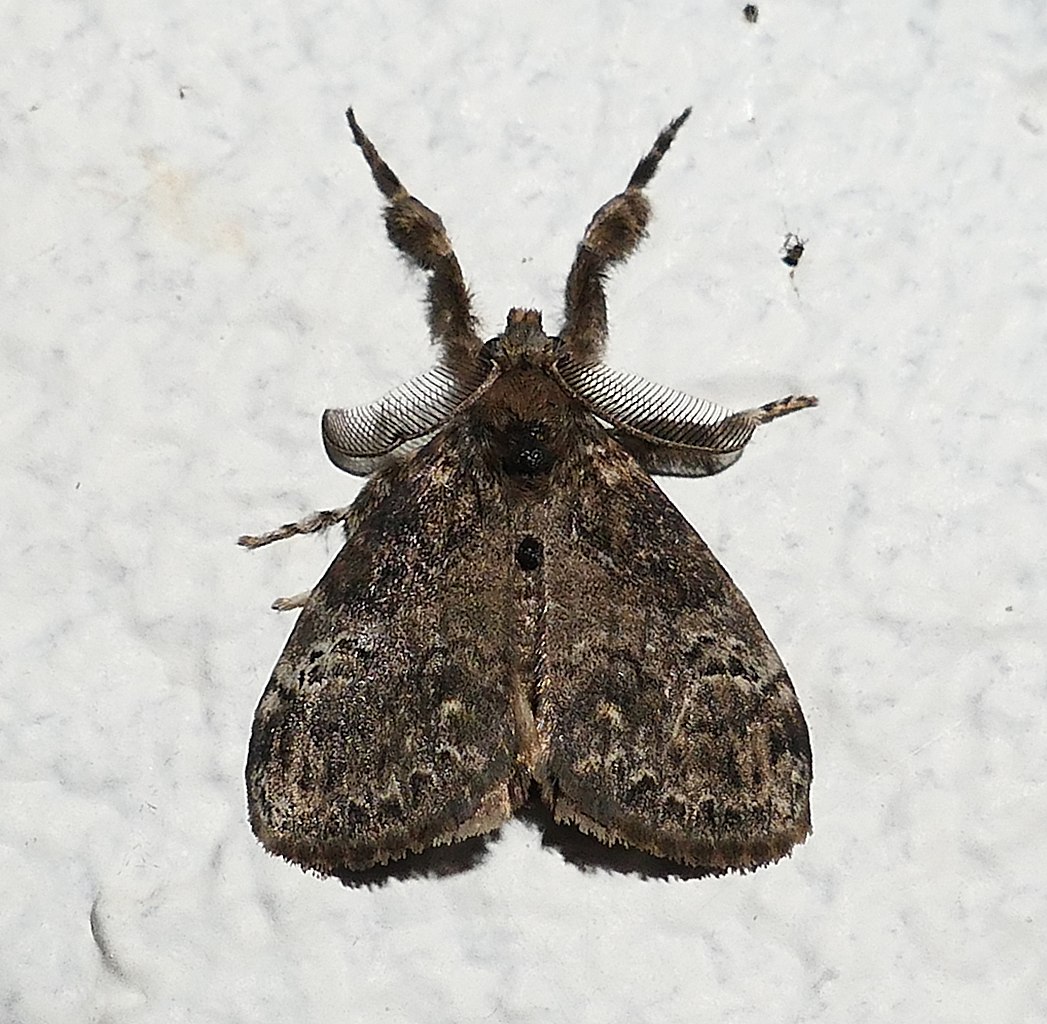
Fir Tussock Moth (Orgyia detrita) is rarely seen on fir, despite their name. Oak, maple, and hackberry are more likely to be the hosts of this species’ caterpillars.
A different combination of brown colors is specific to this species.
Fir Tussock Moths are among the prevalent species around homes with oaks or birch trees.
The hairy caterpillars of this species may cause dermatitis in direct contact.
Handling these caterpillars by hand or removing them from trees by hand isn’t recommended.
Mostly seen in Texas throughout the year, Fir Tussock Moth Caterpillars may also overwinter as eggs.
Wingspan – 0.7 to 1.4 inches
34. Fractured Western Snout
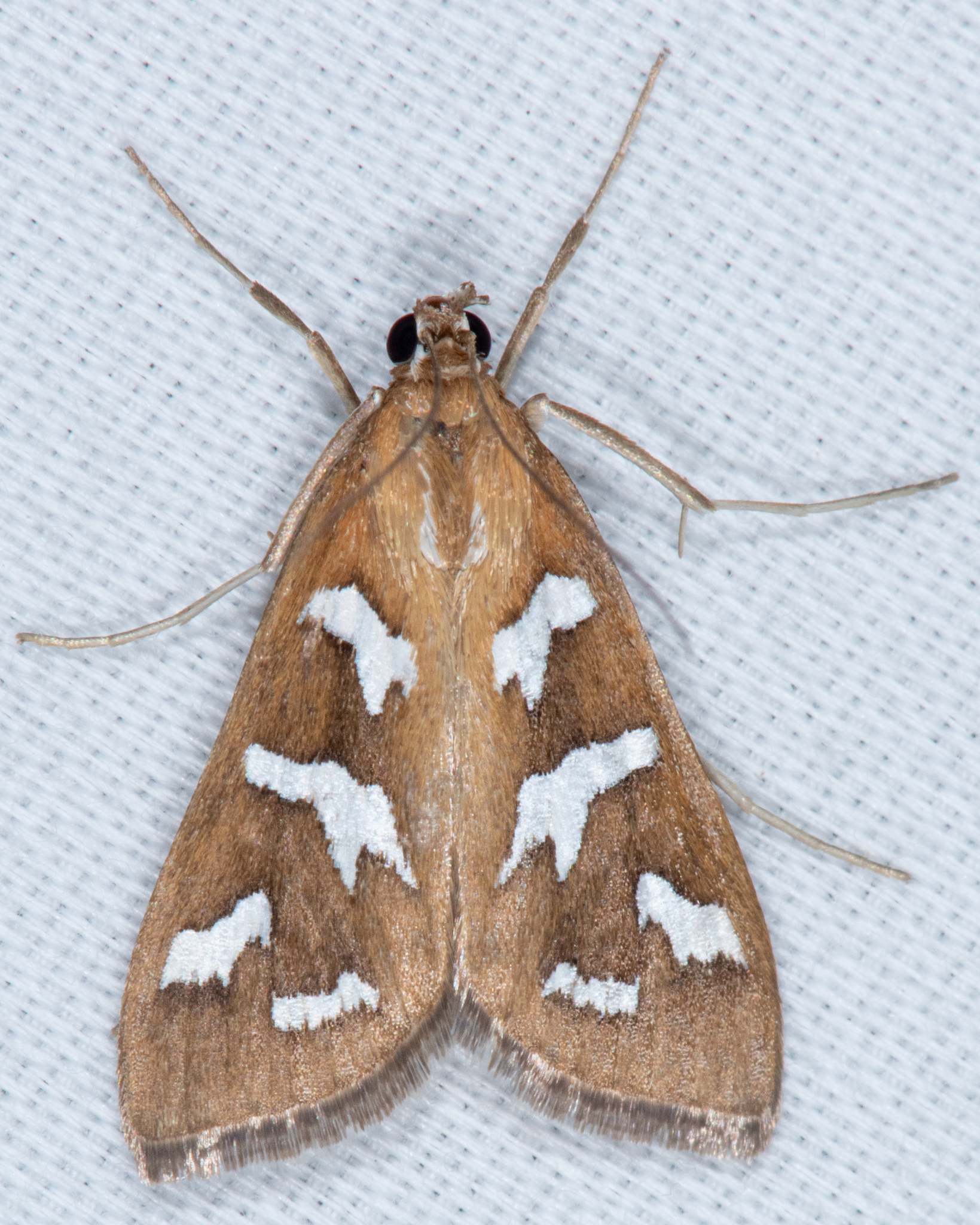
Found in the arid climates in the Southern parts of the state, Fractured Western Snout Moths (Diastictis fracturalis) have a small size and varying colors.
Orange and gray contrasting colors are mostly specific to this species which also come in different colors.
This includes a yellow morph and a dark brown morph.
Fractured Western Snout moths fly during the day and the night. They are a year-round presence in the South and an early presence since February in other parts of the state.
Wingspan – 0.3 to 0.5
35. Eubolina Moth
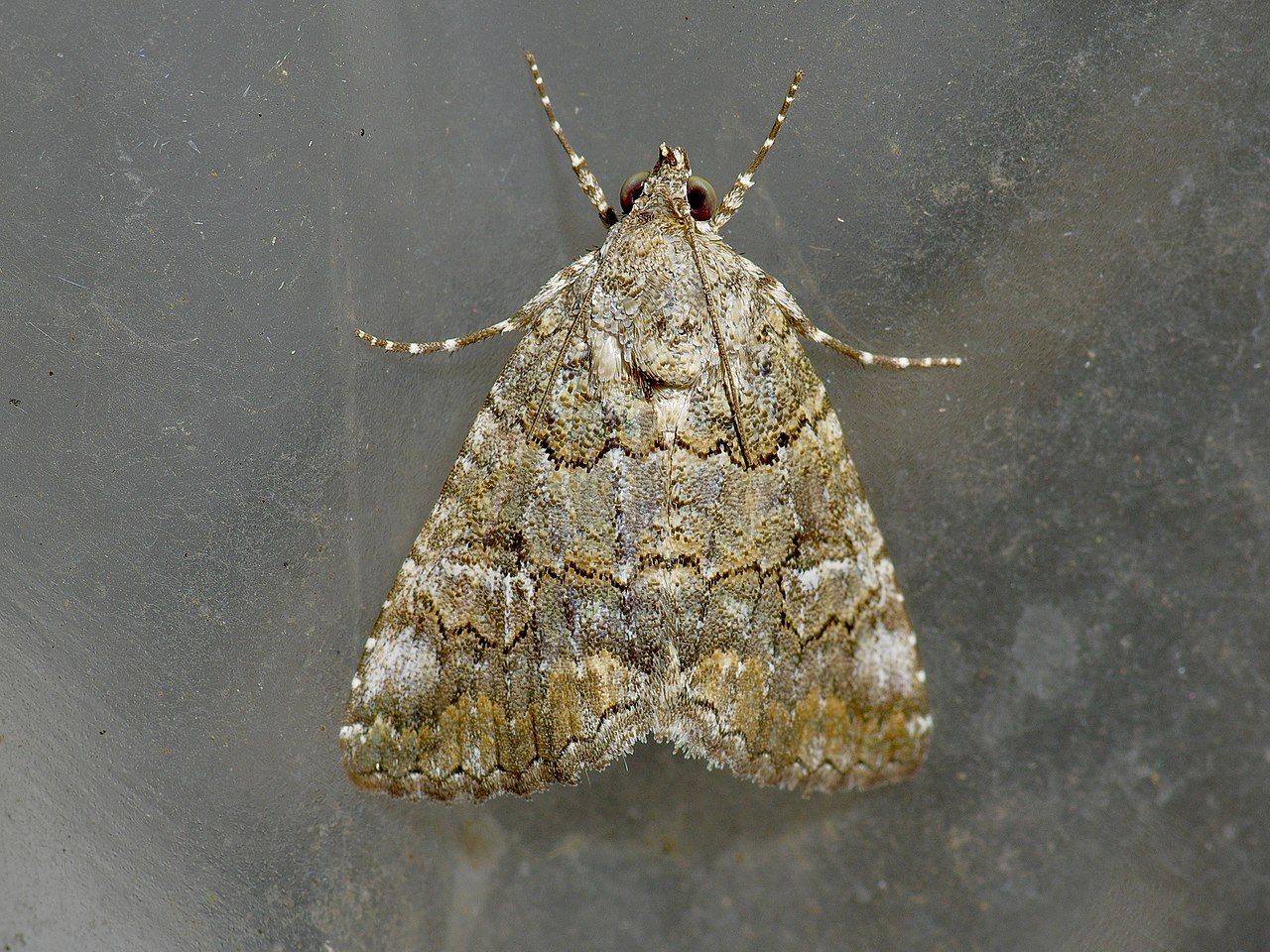
Mostly found in Texas and partly in Louisiana in its US range, The Eubolina Moth (Eubolina impartialis) has a colorful brown, black, white, and yellow appearance.
Its hindwings are considerably brighter than its forewings as they’re mostly bright yellow, as is the lower body.
The forewings and the thorax are dark brown, black, and white, as are its legs and antennae.
Eubolina Moths are some of the first types of moths to be documented on the territory of the state given their native presence and widespread distribution across Texas.
Wingspan – 0.9 to 1.2 inches
36. Snowy Urola Moth

This species (Urola nivalis) is named after its white appearance. A pearl-white appearance is specific to this moth.
Its forewings have a white spotless appearance with brown or orange margins.
Different types of hosts are associated with the species. Olives are always at risk as their caterpillars might feed on olive leaves.
Various species of privet are also hoists of the species which means The Snowy Urola Moths are also found in urban and suburban areas.
Snowy Urola Moths are seen in a couple of generations per year around the state.
Wingspan – 0.5 to 0.9 inches
37. Waterlily Leafcutter Moth

Waterlily Leafcutter Moths (Elophila obliteralis) are some of the smallest yet highly damaging pest moths in the state.
They have dark brown forewings and hindwings being among the few species which don’t exhibit considerably brighter hindwings.
Moths of this species feed on aquatic plants, particularly on lakes, ponds, and canals.
They invade flower garden ponds feeding on the plants. Their role is also positive as they feed on invasive water plants in Texas.
Salvinia and waterlilies are among the most typical hosts for the caterpillars of Waterlily Leafcutter Moths.
Wingspan – 0.5 to 0.7 inches
38. Cellar Graphic

Cellar Graphic moths (Melipotis cellaris) are black and white, despite their name. This is a species dependent on water plants which is where it lays its eggs.
Apart from serving as a safe spot to lay eggs, Cellar Graphic caterpillars also feed on aquatic plants found in lakes and ponds.
These caterpillars are some of the smallest in the state, growing to a length of up to 0.3 inches.
Adult Cellar Graphic Moths are also small compared to other local species. Much of their movements are nocturnal which means these moths might not be easily spotted despite their common nature.
Wingspan – 0.3 to 0.8 inches
39. Lunate Zale Moth

A dead leaf appearance is mostly representative of the Lunate Zale Moth (Zale lunata).
This species is not exclusive to Texas but it is native to the Southern parts of the state.
Lunate Zale Moths have a light brown and a dark brown appearance.
A similar color pattern is seen across its body, forewings, and hindwings.
The caterpillars of the species also use mimicry to escape predators. They have a gray-brown color which makes them similar to twigs.
Wingspan – 1.5 to 2.1 inches
40. Blackberry Looper Moth

The green base color is specific to The Blackberry Looper Moth (Chlorochlamys chloroleucaria) through its life stages.
Both the moth and the caterpillar of the species have a bright green color.
This moth has green forewings and hindwings, with a bright contrasting wave-like pattern across.
Its caterpillar shows a similar emerald green color without any contrasting marks.
This species feeds on blackberry leaves and fruits as a caterpillar and may invade gardens or plantations across the state.
Wingspan – 0.5 to 0.9 inches
41. Drab Brown Wave

A tan color is specific to Drab Brown Wave Moths (Lobocleta ossularia). These species have brown contrasting wave-shaped patterns across the forewings.
Commonly spotted during the summer, Drab Brown Wave Caterpillars are seen on different wildflowers and fruits in gardens or greenhouses.
Caterpillars of this species are among the most common strawberry pests which means they require constant management so they don’t eat the fruit and the leaves of their hosts.
This species can be seen in Texas, but mainly between San Antonio, Dallas, and Houston.
Wingspan – 0.5 to 0.7 inches
42. Variegated Cutworm Moth

This type of moth (Peridroma saucia) is known for its variable appearance. It can be almost completely dark brown or it may have a cream and gray appearance.
Different colors such as gray and brown nuances are also characteristic of its caterpillars.
These caterpillars are seen on some of the most common flowers of the state which include carnation.
Damages caused to their host plants are considerable and this is why they need to be removed.
For example, the caterpillars of the species feed cut through the stems of the plant next to the ground as they may overwinter in the ground.
Wingspan – 1.3 to 2 inches
43. Lucerne Moth

Cover crops of Texas are mostly the areas this moth (Nomophila nearctica) and its caterpillars are seen in.
A common pest of these crops, Lucerne Moths may invade alfalfa crops and also settle on various clovers.
The impact on these crops isn’t as significant as with other species.
Lucerne Moths are named after the European name of alfalfa and they come in different brown colors.
Bright and dark brown nuances are specific to this moth.
Wingspan – 0.9 to 1.3 inches
44. Vine Sphinx
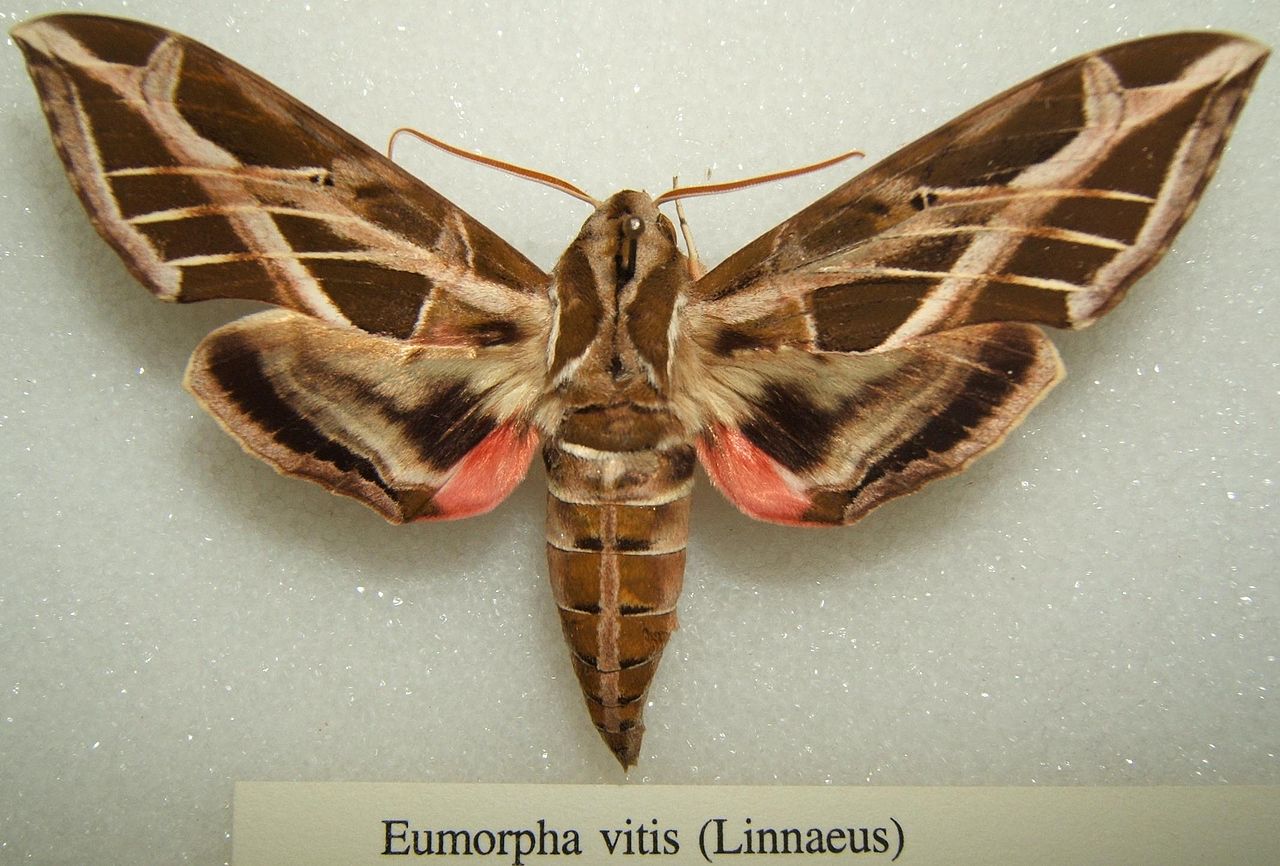
Grapes, vines, and rosy periwinkles are among the local species Vine Sphinxes (Eumorpha vitis) invade.
This type of moth has a long wingspan and a dark appearance. A black body with a few contrasting bright stripes and pink spots is specific to the dorsal side of this moth.
Its ventral side is dominated by bright brown colors.
Vine Sphinx invades vineries and vines at home.
While common in Texas, Vine Sphinxes are more of a pest problem in Central and South America.
Wingspan – 3.3 to 4.1 inches
45. Spotted Beet Webworm Moth

Spotted Beet Webworm Moths (Hymenia perspectalis) have a dark, almost black appearance. Dark gray and black colors are contrasted by bright bands across the wings.
Moths of this species are known to be pests of potatoes. They also invader statewide greenhouses to feed on tropical flowering plants.
Adults of the species feed on flower nectar while caterpillars feed on the leaves of various wildflowers.
Wingspan – 0.6 to 0.8 inches
46. Green Oak-Slug Moth

A distinctive fuzzy green and gray-brown look is specific to this oak-eating moth species (Euclea incisa).
Green Oak-Slug Moths have green central wings coloring.
The caterpillars of this species also have green bodies with green spines. They feature additional pink to red spines.
Young oak leaves are eaten by these caterpillars. In time, this may lead to stunted growth.
Wingspan – 0.5 to 1.2 inches
47. Yellow-collared Scape Moth

Seen in 2 subspecies along the state’s forests, Yellow-collared Scape Moths (Cisseps fulvicollis) are named after the yellow band behind their heads.
This is a type of black moth with black forewings and a black body.
It features long black antennae and all-black legs.
The moth is spotted on different grasses, particularly sedges. Ideal locations for these grasses include vegetated areas around woodlands as well as roadsides.
Wingspan – 1.1 to 1.4 inches
48. Pannaria Wave
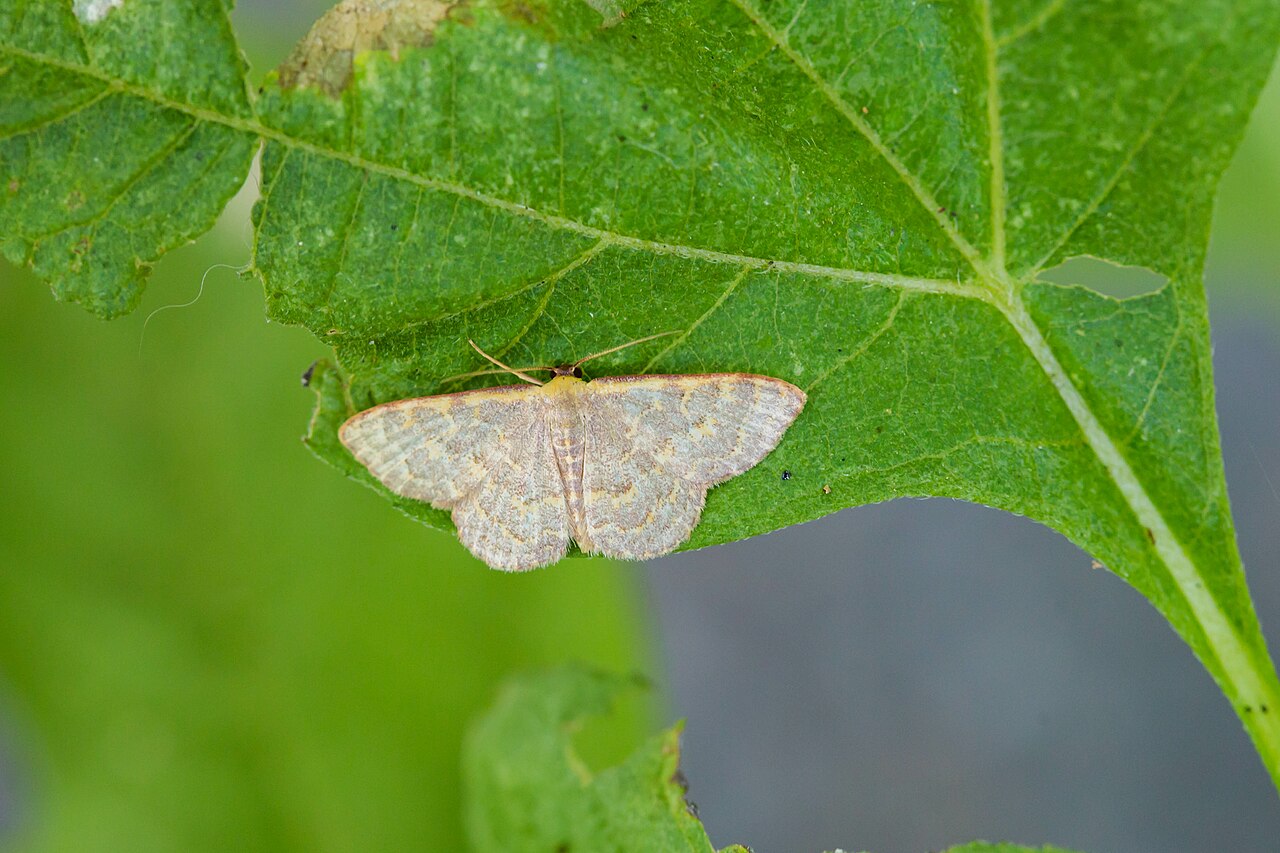
Pannaria Wave moths (Leptostales pannaria) are among the beneficial species to the local ecosystem through their feeding habits.
This species is responsible for eating ragweeds and other types of toxic invasive weeds in the state.
A gray-green appearance is specific to this species even if it also comes in a bright brown morph.
A dark brown margin is seen along the upper wings of the moth.
Wingspan – 0.4 to 0.6 inches
49. Virginian Tiger Moth

Pearl white coloring is specific to the body and the forewings of The Virginian Tiger Moth (Spilosoma virginica).
The caterpillar of the species has a hairy and yellow appearance.
Virginian Tiger Moth Caterpillars hurt the ecosystem and crops, particularly cover crops.
A high appetite means they eat entire leaves, only leaving leaf veins behind.
There are up to 3 broods of Virginian Tiger Moths per year in Southern Texas.
Wingspan – 0.4 to 2 inches
50. Exposed Bird Dropping Moth

Gardens and open fields of the state where hollyhocks grow are the best places to spot Exposed Bird Dropping Moth (Tarache aprica).
Moths of this species are known species to eat and even kill various types of rosacea host plants.
This species is named after the mimicry tactics of its caterpillar which looks like bird droppings.
Even emerged moths have a bright color with multiple dark brown spots to mimic bird droppings, an approach believed to keep predators away.
Wingspan – 0.5 to 1.1 inches
51. Common Eupithecia Moth

Junipers and clover are among the typical Texan hosts of the Common Eupithecia Moth Caterpillar (Eupithecia miserulata).
This caterpillar has a green body with brown dorsal patterns.
The adults of the species are brown moths with gray marks or gray moths with dark gray marks and mottling.
Moths of this species are known to turn to riparian area hosts such as willow in the absence of their favorite plants.
Wingspan – 0.4 to 0.7 inches
52. Imperial Moth

Imperial Moths (Eacles imperialis) are one of the largest moth species in Texas. While not as common as other moths, this species may reach a wingspan of 6 inches.
Yellow and brown colors alternate on its wings and body.
This makes the species easy to spot on its multiple types of hosts on crops, meadows, gardens, parks, and along roads.
Some of the most common plant hosts of The Imperial Moth include sweetgum, oak, and sassafras.
Wingspan – 3.1 to 6.8 inches
53. Common Tan Wave

Named after its dominating tan color, The Common Tan Wave moth (Pleuroprucha insulsaria) also shows a pattern of waver-like bands across its wings.
The species is mostly tied to different trees, particularly hardwood trees in the state.
Oak and chestnut offer the most common food source for its caterpillars which feed on their leaves.
Not all moths of the species are known to migrate but some may come into Texas from other states for food.
Wingspan – 0.5 to 0.8 inches
54. Bent-lined Carpet

Active throughout the year across the state, The Bent-lined Carpet Moth (Costaconvexa centrostrigaria) comes with small visible differences between the sexes.
Both are gray and brown but female Bent-lined Carpet Moths have darker inner wings.
Mostly active at night, this species may also be seen around its host plants during the day. The Bent-lined Carpet Caterpillar feeds on knotweed.
Wingspan – 0.6 to 0.9 inches
55. Diamondback Moth

While not as common as in other states, Diamondback Moths (Plutella xylostella) are among the most problematic types of pest moths in the state.
They are known as a pest of broccoli, cabbage, and cauliflower.
Dark brown coloring is characteristic of the forewings of the species while the hindwing is bright brown.
Wingspan – 0.4 to 0.6 inches